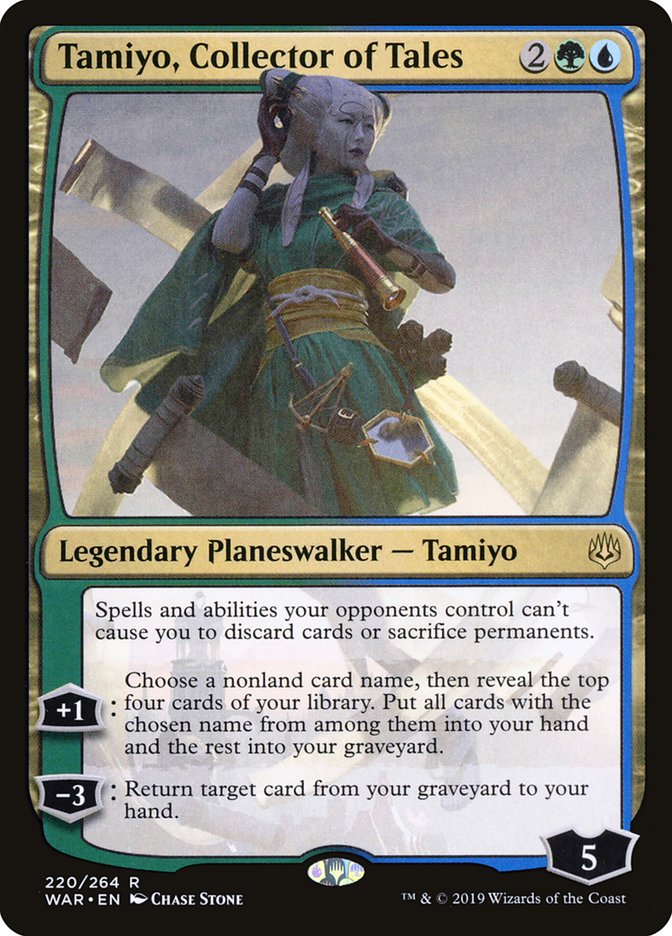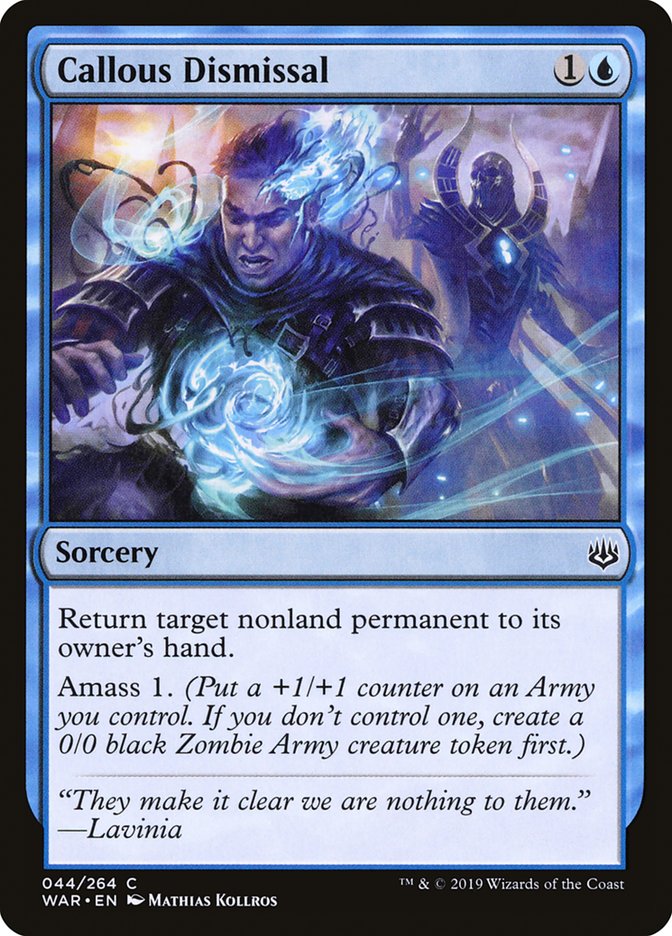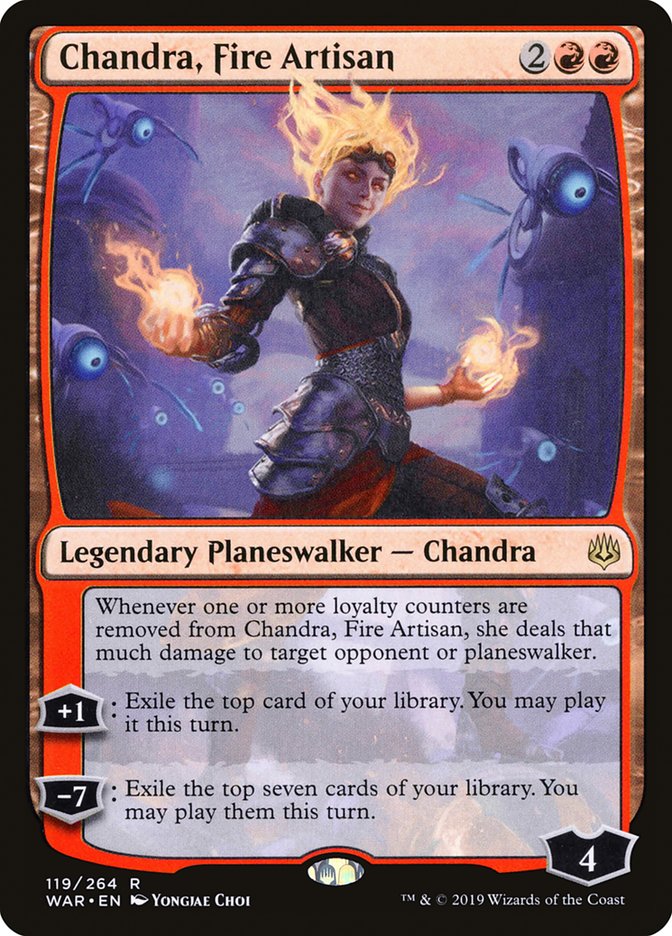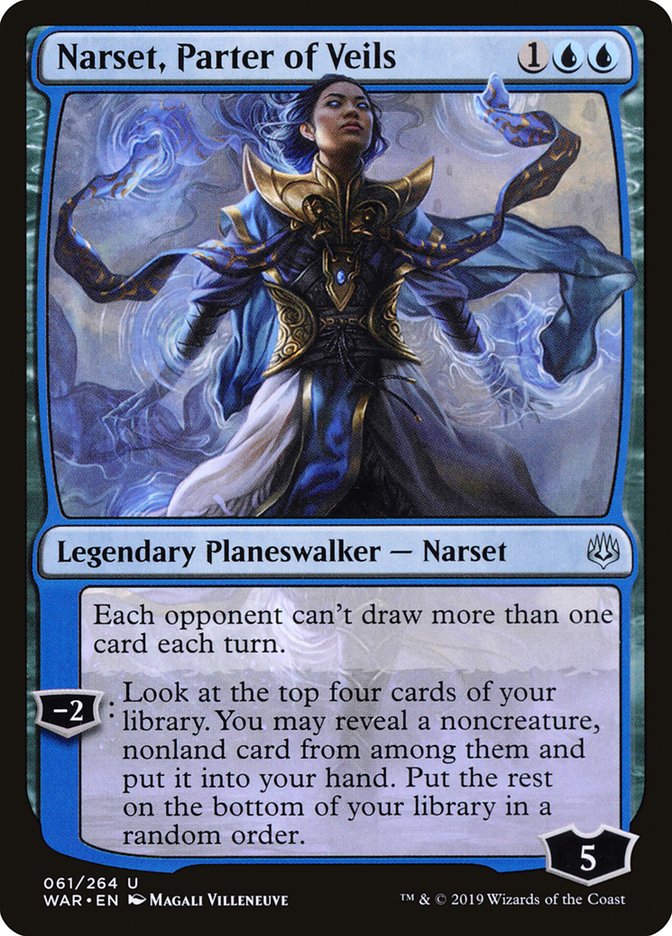Welcome back, faithful readers, to another article from Mox Insights. We’re breaking down SCG Richmond today. A large tournament on Week 1 of a new Standard format is always a treat to tear into. We had been tracking social media like @arenadecklists and player streams leading up to the event to get a lay of the land before the tournament and the results. Looking back on all of it, here’s what we found.
Before Richmond
As players dug into the War for the Spark release, Simic Nexus was the first major deck that boasted significant improvements to the archetype. Tamiyo, Collector of Tales had been somewhat overlooked in preview season but proved to be a potent addition to the deck, functioning as another method to dig for Nexus of Fate but also accelerating the deck towards its non-fail state, where it could take infinite turns. The biggest dispute seemed to be: three copies or four? Commence the Endgame as a new finisher instead of Hydroid Krasis was quickly replaced as Bryan Gottlieb’s suggestion of Callous Dismissal percolated through the Simic Nexus hive mind.
Parallel to Simic Nexus’s revitalization, Esper Midrange was another deck that was emerging as a popular choice among players. Teferi, Time Raveler was the key addition to this deck, as well as players seeking to try a newer variant of Esper decks as Grixis builds began to falter behind the emerging metagame – Grixis, as always, struggling against enchantments like Wilderness Reclamation. Mono-Red Aggro, the best deck at end of Ravnica Allegiance Standard, also was performing well. White aggressive strategies, usually splashing blue, were also faring well. Going into this weekend, we anticipated the top three decks would be Simic Nexus, Azorius Aggro, and Mono-Red Aggro. Esper Control had traditionally fared poorly against Simic Nexus, but an emerging consensus that Esper Midrange did well against Nexus style decks led us to think that Esper decks could be a solid player – just not as popular as those top three.
With the stage set, let us draw back the curtain on SCG Richmond Day 2.
Not Too Hot

Simic Nexus was the largest chunk of the field. It was the talk of the tournament leading up to it. How did it actually do?
| Simic Nexus | 8-23 | 14-16 | 11-13 | 10-1 | 5-2 | 5-7 | 2-5 | 0-5 | 0-3 | 1-4 | – | 3-1 | 2-2 | 1-1 | 2-1 | |
|---|---|---|---|---|---|---|---|---|---|---|---|---|---|---|---|---|
| Mono-Red Aggro | 23-8 | 12-12 | 7-13 | 6-6 | 7-7 | 3-3 | 2-1 | 1-0 | 1-3 | 2-1 | 2-1 | 1-2 | 0-2 | 0-1 | 1-1 | |
| Esper Control | 16-14 | 12-12 | 11-8 | 3-4 | 4-0 | 6-2 | 2-3 | 1-2 | 1-0 | 0-3 | 1-3 | 1-0 | 1-0 | 2-1 | – | |
| Esper Midrange | 13-11 | 13-7 | 8-11 | 3-1 | 4-4 | 2-3 | 1-1 | 3-1 | 2-1 | 2-0 | 2-0 | – | – | 1-1 | 0-2 | |
| Sultai Midrange | 1-10 | 6-6 | 4-3 | 1-3 | 3-0 | 1-1 | – | 1-1 | 2-1 | 1-0 | – | – | – | – | 1-0 | |
| Azorius Aggro | 2-5 | 7-7 | 0-4 | 4-4 | 0-3 | 0-1 | 2-1 | – | 0-1 | – | 0-1 | 1-3 | – | – | 0-1 | |
| Gruul Aggro | 7-5 | 3-3 | 2-6 | 3-2 | 1-1 | 1-0 | 0-2 | 1-0 | 1-0 | 1-0 | 2-0 | 1-0 | – | – | 0-1 | |
| Bant Midrange | 5-2 | 1-2 | 3-2 | 1-1 | – | 1-2 | 2-0 | – | 1-0 | – | – | – | – | – | 1-0 | |
| Mono-White Aggro | 5-0 | 0-1 | 2-1 | 1-3 | 1-1 | – | 0-1 | – | 0-1 | – | – | – | 0-1 | – | – | |
| Mono-Blue Aggro | 3-0 | 3-1 | 0-1 | 1-2 | 1-2 | 1-0 | 0-1 | 0-1 | 1-0 | – | – | – | – | – | – | |
| Bant Nexus | 4-1 | 1-2 | 3-0 | 0-2 | 0-1 | – | 0-1 | – | – | – | – | – | 1-0 | 0-1 | – | |
| Orzhov Aggro | – | 1-2 | 3-1 | 0-2 | – | 1-0 | 0-2 | – | – | – | – | – | – | 0-1 | – | |
| Naya Feather | 1-3 | 2-1 | 0-1 | – | – | 3-1 | 0-1 | – | – | – | – | – | 1-0 | – | – | |
| Jeskai Feather | 2-2 | 2-0 | 0-1 | – | – | – | – | – | 1-0 | – | 0-1 | – | 0-1 | – | – | |
| Dimir Midrange | 1-1 | 1-0 | 1-2 | 1-1 | – | – | – | – | – | – | 1-0 | 1-0 | – | – | – | |
| Bant Flash | 1-2 | 1-1 | – | 2-0 | 0-1 | 1-0 | 1-0 | 0-1 | – | – | – | – | – | – | – | |
|
Simic Nexus
|
Mono-Red Aggro
|
Esper Control
|
Esper Midrange
|
Sultai Midrange
|
Azorius Aggro
|
Gruul Aggro
|
Bant Midrange
|
Mono-White Aggro
|
Mono-Blue Aggro
|
Bant Nexus
|
Orzhov Aggro
|
Naya Feather
|
Jeskai Feather
|
Dimir Midrange
|
Bant Flash
|
| 80 | |
| 70 | |
| 60 | |
| 50 | |
| 40 | |
| 30 | |
| 20 |
…Not that great. Simic Nexus was one of the lesser-finishing decks in the tournament, posting a just-sub-45% win rate in Day 2. Without Day 1 data, we can’t conclusively say that Simic Nexus is a bad deck, though. It might be that Simic Nexus was a great Day 1 deck – it fared extremely well against Ravnica Allegiance Standard players such as Azorius Aggro and Sultai Midrange – yet struggled on Day 2 as it ran into many, many Mono-Red players.
While Simic Nexus didn’t put up the strongest finish, we wanted to contextualize it in the context of Simic Nexus being one of the most-known and prepared-for quantities. The deck still has strong potential and the Mono-Red matchup could perhaps be aided through a strong redesign of the list – perhaps focusing more tightly on Bond of Flourishing and Narset, Parter of Veils. In fact, two copies of Narset snuck their way into fourteenth-place finisher Nick Schirillo’s list:
Planeswalkers (6)
Lands (15)
Spells (39)
- 6 Forest
- 6 Island
- 2 Negate
- 3 Search for Azcanta
- 2 Blink of an Eye
- 4 Nexus of Fate
- 4 Root Snare
- 4 Chemister's Insight
- 4 Growth Spiral
- 4 Wilderness Reclamation
Sideboard

Narset, Parter of Veils as a mirror-breaker was an early tech choice in player’s sideboards as Simic Nexus grew in popularity on Arena. This main deck inclusion is something different, but both top finishing Simic Nexus decks played her maindeck. If there was a re-design of Simic Nexus around Bond of Flourishing curving into Narset, Parter of Veils into your four-drops like Tamiyo, Tale Collector and Wilderness Reclamation, we think points could be made up in the Mono-Red matchup as well as Esper Control, the other major pillar of the format coming out of this weekend. As it was, however, players were ready for Simic Nexus. Even Esper Control players seemed well-prepared to beat it. Conventional wisdom on the matchup had suggested that Simic Nexus was a favorite, but based on this Day 2 it’s much closer to even. (Ironically, Esper Midrange was regarded as a solid favorite versus Nexus, but that matchup was also closer than anticipated.)
Bant Nexus was in the hands of a couple of pilots, both with different takes on that specific splash, so it’s difficult to comment on them with a quantitative analysis. That said, they did well in the mirror, so if your local metagame is still full of Simic Nexus players after this weekend, consider adding white to your deck.
Creatures (3)
Planeswalkers (9)
- 1 Teferi, Hero of Dominaria
- 3 Teferi, Time Raveler
- 3 Tamiyo, Collector of Tales
- 2 Narset, Parter of Veils
Lands (23)
Spells (25)

Even with the poor showing, we don’t think the deck is out of contention as a serious metagame shaper. In fact, Simic Nexus being so popular allowed Mono-Red players to feast on the archetype. It was also the target of the relative newcomer to the tournament, Bant Midrange. The spread of matchups across these Top 16 archetypes suggests to us that you were either extremely prepared – looking at you, Mono-White Aggro players with four copies of Demystify in the sideboard – or not for Simic Nexus. But as we’ll discuss later, the axis around which the format moves could indicate good things for Simic Nexus.
Not Too Cold
We turn now to the dominant aggro decks of the tournament: Azorius Aggro and Mono-Red Aggro. Mono-Red was clearly an excellent choice for the weekend – and we don’t think it was because of the cliche that aggressive, proactive decks are best in Week 1 of a new format. Mono-Red’s Simic Nexus matchup was alone enough to carry it to a strong finish. Mono-Red also got to split major matchups against Sultai Midrange, Azorius Aggro, and Esper Control.
We don’t have enough data to try to conjecture about Chandra, Fire Artisan, versus Experimental Frenzy, but we would hypothesize that she is fulfilling an important tech role in minimizing how good Esper’s suite of removal is against the deck. Esper players will always have Mortify in their 75, but Mono-Red players can work to make themselves more insulated against it.
Azorius Aggro, conversely, had an overall poor tournament. We can’t recommend this deck right now. Mono-Red’s victories this weekend demonstrated the importance of having reach if you’re an aggressive deck and Azorius is lacking in that crucial ability to close the game. Without reach, aggro decks right now can be shut down by Esper’s removal suite. Azorius Aggro might rise to prominence if Bant Midrange becomes more popular, but that is a ways off right now in the development of the metagame.
In the “other aggro” camp, we should briefly mention Gruul Aggro and the old Mono-Blue Aggro. While Gruul fared well against some of the minor players in the tournament, its abysmal Esper Control matchup keeps us off Gruul Aggro in the coming weeks. Similarly, Mono-Blue Aggro did well against Mono-Red and Simic Nexus but tanked versus Esper.
Let’s turn now to the gatekeepers of the Standard format.
Just Right
| Simic Nexus | 8-23 | 14-16 | 11-13 | 10-1 | 5-2 | 5-7 | 2-5 | |
|---|---|---|---|---|---|---|---|---|
| Mono-Red Aggro | 23-8 | 12-12 | 7-13 | 6-6 | 7-7 | 3-3 | 2-1 | |
| Esper Control | 16-14 | 12-12 | 11-8 | 3-4 | 4-0 | 6-2 | 2-3 | |
| Esper Midrange | 13-11 | 13-7 | 8-11 | 3-1 | 4-4 | 2-3 | 1-1 | |
| Sultai Midrange | 1-10 | 6-6 | 4-3 | 1-3 | 3-0 | 1-1 | – | |
| Azorius Aggro | 2-5 | 7-7 | 0-4 | 4-4 | 0-3 | 0-1 | 2-1 | |
| Gruul Aggro | 7-5 | 3-3 | 2-6 | 3-2 | 1-1 | 1-0 | 0-2 | |
| Bant Midrange | 5-2 | 1-2 | 3-2 | 1-1 | – | 1-2 | 2-0 | |
|
Simic Nexus
|
Mono-Red Aggro
|
Esper Control
|
Esper Midrange
|
Sultai Midrange
|
Azorius Aggro
|
Gruul Aggro
|
Bant Midrange
|
”
| 80 | |
| 70 | |
| 60 | |
| 50 | |
| 40 | |
| 30 | |
| 20 |
When we dial in tightly on the Top 8 archetypes, we start to see why this was really Esper’s tournament, despite Mono-Red claiming three of the Top 4 finishes. The two Esper archetypes, Esper Control and Esper Midrange, posted excellent win rates against the spread of the Top 8. Where they start to separate is in their favorable matchups. Esper Control got to prey on Esper Midrange, while Esper Midrange got to attack the Mono-Red players. Esper Control also had the tools to deal handily with Gruul and Azorius Aggro, giving it a slight edge over the Esper Midrange players. Whichever archetype you prefer (we endorse Esper Control), there is a case to be made for either deck as the metagame evolves. Esper right now is simply the color combination that has the best spread of reactive cards, making it the “Jund”-style deck with the ability to tune itself week to week to attack the metagame, with a slight edge against the field.
While Mono-Red won the tournament, we believe that Esper will be the deck that players must react to. Simic Nexus players are exposed: they have a clearly bad matchup they need to fix in Mono-Red. Mono-Red players don’t have strong indicators that they should move one way or another in the metagame: they crush Nexus, struggle against Esper, but are also doing well against the newcomers like Bant Midrange. But Esper players now get to look at the broad metagame and identify their enemies and what they need to beat them. You can see two different philosophies in the two Top 8 Esper decks. Edgar Magalhaes’s build targets creature decks with a hammer by maxing on Kaya’s Wrath and Oath of Kaya. Zach Allen’s deck leans more towards point-and-click removal, utilizing Moment of Craving and maxing on Vraska’s Contempt. Both strategies have merit. The archetype has a ridiculous amount of customizability, a classic “Jund” style.
Planeswalkers (6)
Lands (25)
Spells (29)

Planeswalkers (7)
Lands (26)
Spells (27)

Esper decks being the reactive player’s choice poses some conundrums to the field. How should players attack Esper Control? Let’s talk planeswalkers and Bant Midrange. Planeswalkers are among the few difficult-to-answer permanents for Esper, as their best answer (until The Elderspell becomes more common) is four mana. Players utilizing Narset, Parter of Veils or Teferi, Time Raveler are picking up points versus Esper decks by interfering with the Esper draw engine or the Esper answer plan. Building around these strategies might be a way to attack Esper’s metagame dominance.
Moving Forward
As always, we wanted to plot win rate versus metagame share to offer the best deck from this weekend. This might suggest Esper Control is the best deck in the format, but it does have potential holes that players will seek to exploit. Bant Midrange is a very new deck that only broke late last week as an emerging player in the metagame. It still has lots of space and ability to refine, especially as it looks to shore up what has proved to be a soft Mono-Red matchup. If you want to play Esper Control, don’t expect to take a stock list and do well – you need to be prepared for the shifts in the metagame and moving in reaction to others if you want to maintain that Jund-like ability to do even to slightly well against everything.
Two of the three-mana planeswalkers really impressed us and we encourage you to take a deeper look at their potential: Narset, Parter of Veils, and Teferi, Time Raveler. Narset’s impact on the format is just in its beginning stages, we think: Narset, Parter of Veils has countless interactions with a variety of pillars of the previous Standard format. She minimizes the damage of Risk Factor; she’s a choke piece against Simic Nexus and control decks; and she almost entirely negates Niv Mizzet, Parun singlehandedly, not to mention her potential impact in non-rotating formats like Modern and Legacy. Narset was impactful in a variety of decks, from Dimir Midrange to classic Esper Control to even Simic Nexus itself.
Teferi, Time Raveler is poised to be one of the most important rare planeswalkers in War for the Spark Standard. We crunched the numbers:
|
Maindeck copies of Teferi, Time Raveler |
Match Win Rate |
|
0 |
62% |
|
1 |
64% |
|
2 |
63% |
|
3 |
67% |
While these numbers are not authoritative, they seem to indicate that Teferi, Time Raveler was influential in a player’s success. A similar pattern followed for total copies of Teferi, Time Raveler in a player’s deck: an overall 5% increase in win percentage from zero copies to three copies. He does seem to have diminishing returns, though – four copies is where you actually lose some win percentage, which was consistent in both maindeck and total copies.
Teferi, Time Raveler even has penetrated into the Azorius Aggro decks, as people have begun utilizing him as a tempo tool. On his own, he’s one of the most important lock pieces against Simic Nexus, which was poised to be a key player this weekend. Ironically, he also might be one of the best tools Nexus decks could utilize if they’re willing to splash Bant and undergo a radical redesign of the core Nexus deck, much like Johnathan Goanos did, or go for the Bant Midrange that took Harlan Firer and Rudy Briksza to the Top 8. This Bant Midrange deck, we think, has high potential moving forward if it can address the Mono-Red matchup meaningfully.
Where the metagame will move next, though, depends on how players move in response to Mono-Red’s victory. Esper isn’t going anywhere, and neither are we. We’ll see you in two weeks for another Standard breakdown of SCG Syracuse!








